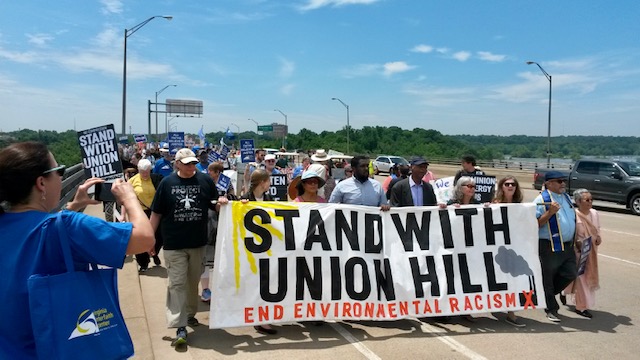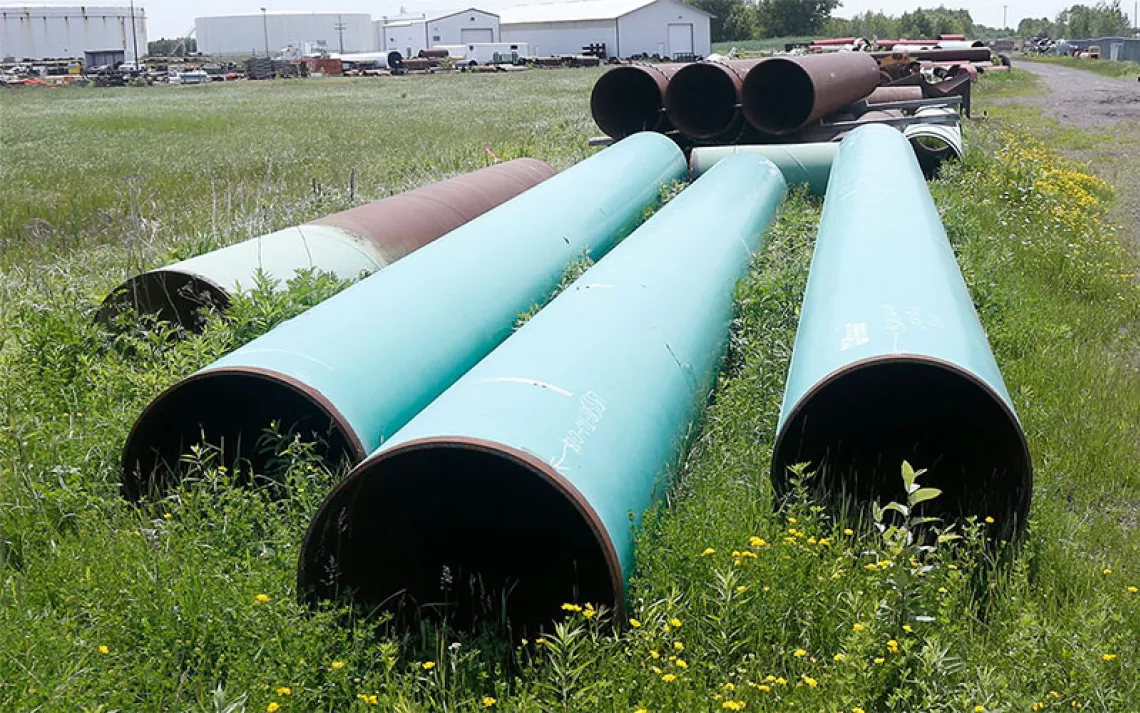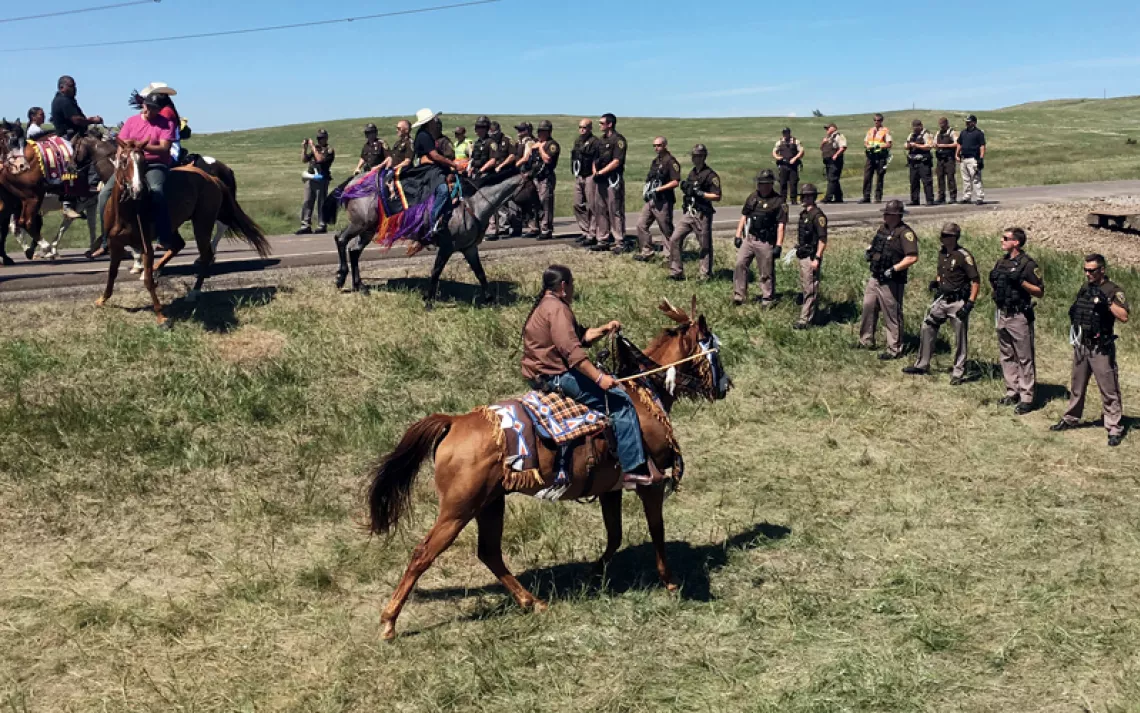Sustained Opposition Derails Three Major Oil and Gas Pipelines
Grassroots resistance shuts down Atlantic Coast, Dakota Access, and Keystone XL

Demonstrators protest on the north side of the White House after President Trump announced two executive orders advancing the Keystone XL and Dakota Access Pipelines on January 24, 2017. | Photo by Riccardo Savi via AP Images
In a major defeat for the Trump administration, one major pipeline project was canceled and two others shut down this week after years of sustained grassroots opposition. While the outcome for two of the pipelines remains uncertain, this week’s developments represent a major victory for a diverse coalition of community organizers, volunteer residents, tribal members, scientists, farmers and landowners, climate activists, and outdoor enthusiasts who spent years fighting to keep the pipelines off their lands.
Chad Oba, a resident of Union Hill, Virginia, first learned about the proposed Atlantic Coast Pipeline in 2014, when a friend called to tell her about it. The joint project of Dominion Energy, based in her state, and Duke Energy, based in North Carolina, would ferry fracked gas from West Virginia into Virginia and North Carolina through a zigzagging 42-inch-wide pipe. It would also require a huge compressor station within a mile of Union Hill—potentially creating significant air, water, and noise pollution. Oba began networking with friends and neighbors, collecting names on petitions, and participating in church meetings. Those meetings led to the creation of the Friends of Buckingham, which dedicated itself to defending Union Hill, Buckingham’s historically Black community, against the project.
“There hasn’t been a day in my life in the last six years that I haven’t tried to stop this project from taking place,” Oba told Sierra.
Two years later, Dr. Ryan Emanuel, an environmental scientist at North Carolina State University and a member of the Lumbee Tribe in Robeson County, watched with alarm as Dominion and Duke began preliminary infrastructure for the pipeline at its planned terminus there: felling trees, raising barbed-wire fences and security cameras, and laying pipe. Emanuel began studying the potential impacts of the project on the Lumbee and other Indigenous peoples. In a public filing with the Federal Energy Regulatory Commission, he provided crucial research demonstrating that the Atlantic Coast Pipeline would have a disproportionate impact on 30,000 Native American residents living in the FERC-defined study area of the project. While they represent only 1.2 percent of North Carolina’s population, he showed, they make up over 13 percent of those living within one mile of the pipeline’s proposed route through the state.
“The people shouldering the worst burdens of climate change are poor and minority communities,” he told Sierra. “Our community would have been asked to shoulder all the energy burdens in the state for this pipeline had it gone forward, and they would still get a raw deal in the end in terms of seeing the negative impacts of climate change: heat, drought, and natural disasters.”
Oba and Emanuel are just two of the activists in a broad opposition movement that spent six years trying to prevent the Atlantic Coast Pipeline from being permitted. They prevailed on July 5, when Dominion and Duke announced they would abandon the project.

A protest rally in Richmond, Virginia, against the Atlantic Coast Pipeline in May 2019. | Photo courtesy of Chad Oba
Two other oil pipelines—Dakota Access, which is already in operation, and Keystone XL, which has been built in sections—were also shut down after legal rulings affirmed that developers, along with the US Army Corps of Engineers, had failed to properly assess the impact of the projects on the environment and endangered species.
The reversals are a major defeat for the Trump administration, which has prioritized dirty fossil fuel projects above nearly every other domestic initiative. The developments also affirmed the significance of legacy environmental laws such as the National Environmental Policy Act (NEPA), which has become the pivot point in the Dakota Access case, among others. NEPA is now a target for a planned Trump administration rollback that could be announced within weeks.
Had it been built, the Atlantic Coast Pipeline would have carried fracked gas through Native American land, tunneled under aquifers as well as the Appalachian Trail, and carved a scar through some of the richest landscapes and most fragile ecosystems in the mid-Atlantic, including the George Washington and Jefferson National Forests and the Cheat and Shenandoah Mountains. Opponents of the project, including the Sierra Club, had successfully tied it up in court with legal challenges demonstrating that the federal permitting process and environmental review had been rushed and inadequate. As a result, the project was three years behind schedule and over $3 billion over budget.
The EPA issued an extraordinary tweet lamenting the pipeline’s demise. “While Duke Energy's permit delays were not associated with EPA permits, the agency has made significant progress under the Trump administration clearing inherited backlogs & streamlining processes to ensure more certainty for American companies seeking to develop energy projects,” the agency tweeted, adding, “It's a shame litigation will force Americans to rely more on dirtier imported energy at expense of US jobs.”
Remarkably, the Environmental Protection Agency’s comment ignores the environmental impact of the proposed pipeline. A 2017 report by Oil Change International and Bold Alliance found that the Atlantic Coast Pipeline would produce annual emissions of nearly 68 million metric tons of carbon dioxide—the equivalent of adding 20 coal plants or 14 million passenger vehicles. Also, methane leaks are unavoidable in the natural gas supply chain and are a significant heat-trapping greenhouse gas, contributing to global warming.
After the decision was made public, Dominion announced that it was selling its fracked gas pipeline business to Warren Buffet’s Berkshire Hathaway Energy for $10 billion.
The next day, July 6, a federal judge ordered Energy Transfer Partners LP to shut down its three-year-old, 1,172-mile Dakota Access Pipeline and empty it of all oil until a stronger environmental analysis could be conducted. The judge ordered the Army Corps of Engineers to address multiple NEPA violations and to complete a full environmental impact statement before the project can be reactivated, finding that its previous EIS was woefully inadequate. The decision marked the first time a federal judge had ordered an operating pipeline be shut down because of its environmental impact and was a major victory for the Standing Rock Sioux and the Cheyenne River Sioux Tribes.
“The Court does not reach its decision with blithe disregard for the lives it will affect,” wrote US District Judge James Boasberg. “Yet, given the seriousness of the Corps’ NEPA error, the impossibility of a simple fix, the fact that Dakota Access did assume much of its economic risk knowingly, and the potential harm each day the pipeline operates, the Court is forced to conclude that the flow of oil must cease.”
“This decision demonstrates the power and the importance of NEPA,” Caitlin McCoy, a staff attorney with the Harvard Law School Environmental and Energy Law Program, told Sierra. “When you read the decision, you see the way the court talks about the importance of an agency considering all the impacts of a project before undertaking that project. The blame lies with the Army Corps of Engineers, which has been working for years to downplay the impacts of this pipeline when it was clear all along that there were significant impacts. Instead of taking the time to do the full EIS, there was a rush to get this project going as soon as possible.”
The Trump administration and its Council of Environmental Quality are soon expected to announce a rollback of NEPA regulations in an attempt to limit the scope of what projects can trigger a NEPA review. Even if the administration does so, however, it will not affect the Dakota Access Pipeline review, according to McCoy, as the judge has already indicated the court expects a full EIS under existing regulations and case law.
Also on July 6, the US Supreme Court blocked a joint request from TC Energy Corp, based in Alberta, Canada, and the Trump administration to allow the company to proceed with constructing the Keystone XL pipeline, effectively delaying the project until at least 2021. The pipeline would carry approximately 830,000 barrels of heavy oil through a 1,200-mile route, starting in Alberta and ending in Nebraska. In April, US District Judge Brian Morris found that Keystone XL had violated the Endangered Species Act and blocked it from operating under its existing permit. The Trump administration sought to have Judge Morris’s order thrown out, but the Supreme Court’s decision this week was a blow to that effort.
The trifecta of decisions represents one of the biggest victories yet of the tribal and environmental movement against fossil fuels.
“There has been a public outcry against the Atlantic Coast Pipeline from a whole range of people, from Indigenous communities to landowners in the hills of Virginia opposing the use of eminent domain, farmers who didn’t want their land taken for this pipeline, and climate activists,” Kelly Martin, the director of the Sierra Club’s Beyond Dirty Fuels Initiative and a North Carolina resident, said. Volunteer members and staff from the Sierra Club’s Virginia Chapter have been organizing and working to stop the project since its inception. “It’s a beautiful example of what can happen when we work together and stay committed.”
“We were persistent. We never gave up,” Oba says. “Even in the dark moments when things weren’t going so well, we pursued every avenue, we reached out for help, and we got it.”
"For me, doing this work was about building and maintaining relationships," Emanuel says. "It was about focusing on the mathematical details of environmental justice. While I was doing that, I was also remembering that these are not just raw numbers and statistics. These are real people that I know and care about. That’s one of the things that drove me to keep pursuing this work."
 The Magazine of The Sierra Club
The Magazine of The Sierra Club



